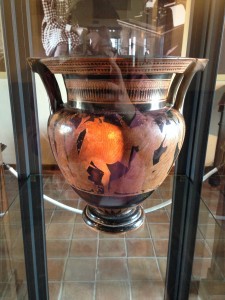On the way to Porto Empedocle, we stopped at the House-Museum of Luigi Pirandello. Born in 1867, Pirandello was a famous Sicilian playwright, novelist, and (as we learned in the museum) a talented painter. On the second floor of the museum, I was shocked to see a Greek vase sitting in a glass case in the center of the room. Finally, a crossroads for the Italian and Latin class!

The vase, as we learned from Professor Boyd, depicts the story of Tereus, Procne, and Philomela, a rendering of which is found in Ovid’s Metamorphoses Book VI. According to Ovid, Procne requested that her husband Tereus, the king of Thrace, fetch her sister, Philomela, from Athens. Tereus obeyed, but as he escorted the sister back to Thrace, he locked her in a cabin and raped her. When Philomela threatened to reveal Tereus’ crime, he cut out her tongue. The now mute Philomela wove a tapestry depicting the wicked act and tricked a servant into delivering it to Procne. As revenge, Procne murdered her own son, Itys, and served the child as a meal to Tereus. The story concludes with all three characters going mad from the traumatic events they had experienced, and the gods transform all three into various birds.
Interestingly, this vase once held the ashes of Luigi Pirandello. The ashes were later transferred to a different container, since the Italian bishops refused to bless the Greek vase as it wasn’t “Christian.” Probably a good thing, however, considering how incredibly gruesome the myth is…